The secret lives of grizzlies
By studying grizzlies in captivity, scientists are gaining insights into how bears—and their hearts—tick.
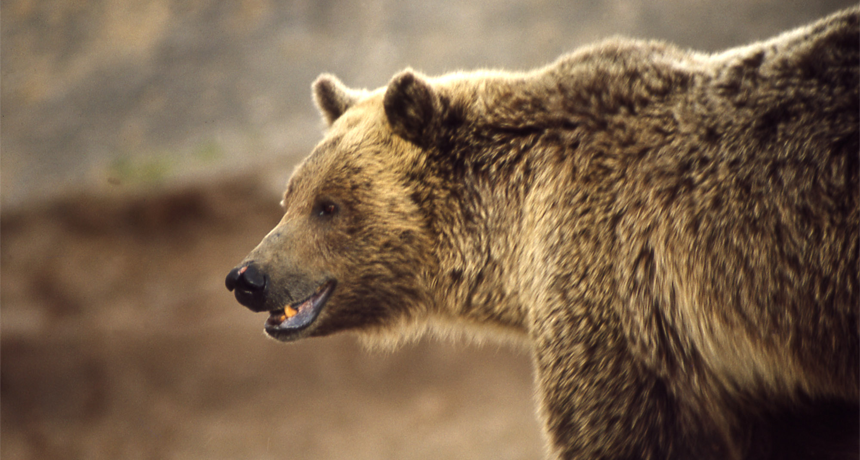
Adult grizzlies are big and powerful.
Bryan Harry/National Park Service
By Emily Sohn
The first time Lynne Nelson entered a den of hibernating grizzly bears, she felt a little nervous. The captive bears had known her since they were babies, but they hadn’t eaten in weeks. And each young-adult animal weighed more than 150 pounds. They weren’t fully grown, but they were definitely big enough to hurt her.
“I didn’t know what to expect,” says Nelson, a veterinarian and heart specialist at Washington State University (WSU) in Pullman. “I didn’t know if they had forgotten us, if they would be fearful or hungry, or wonder why we didn’t bring a big load of food.”
As soon as she and her colleagues walked into the den at WSU’s fenced-in Bear Center, however, they were surprised to find that the resting bears acted just like cubs: They licked the researchers’ faces and tried to sit in their laps.
Now, years later, the grown-up captive bears still act the same way during hibernation, possibly because they feel safe and are free from the stress of having to defend themselves and hunt for food, as they would in the wild.
Such odd, babylike behavior among adult bears is not the only thing that makes grizzlies so interesting, Nelson says. For years, she has been documenting some remarkable changes in the bears’ heart activity during hibernation.
Because bear hearts work like human hearts do, Nelson hopes her findings might one day help doctors better treat heart problems in people. And other research with the eight or so captive grizzlies at WSU’s Bear Center might help scientists understand and protect bears in the wild.
The heart of a bear
Heart rate is one thing people have in common with grizzly bears. An average human heart beats between 60 and 100 times per minute. An average grizzly’s heart runs between 70 and 90 beats per minute (bpm)—but only in the summer.
As winter approaches, grizzlies settle down in protected dens where they will hibernate for 4 to 6 months. During hibernation, the bears don’t sleep all the time but they do stop eating, drinking, and going to the bathroom. They continue to move around, but move more slowly. Over the winter, they lose about 30 percent of their body weight.
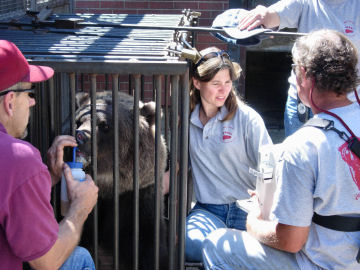 |
|
Lynne Nelson and colleagues at the WSU Bear Research Center have trained grizzlies to cooperate in experiments.
|
| Washington State University |
Scientists have long known that a grizzly’s heart rate drops to between about 5 bpm and 25 bpm during hibernation. But how can a bear’s heart rate stay so low for so long without causing any permanent damage to the animal? It’s a question that scientists would like to answer. Such a slowly beating heart is a sign of major stress in a human. In fact, a person with a heart rate that low would die.
“Why don’t the same kinds of stresses that would kill us affect these bears?” Nelson asks. “That’s the million-dollar question.”
Hibernation investigation
Studying the hearts of hibernating wild grizzlies isn’t easy. Previously, researchers had to trap the bears, put heart monitors on them, and attach tracking collars so they could retrieve the monitors later.
But to get more detailed information, today’s researchers need to monitor an animal’s heart with special equipment. They also need to draw blood samples. These kinds of tests require that an animal sit still for at least 20 minutes at a time. Wild grizzly bears, however, are not known for their cooperation skills.
Researchers have tried using anesthesia to sedate wild bears before collecting measurements. But these drugs slow the heart, among other effects, masking the animal’s natural state.
In 2001, Nelson and her colleagues decided to try a new approach: They adopted two 4-week-old captive female grizzlies, just as the cubs were starting to open their eyes. Bears weigh about 5 pounds at that age, Nelson says. Full-grown adult females weigh up to 450 pounds.
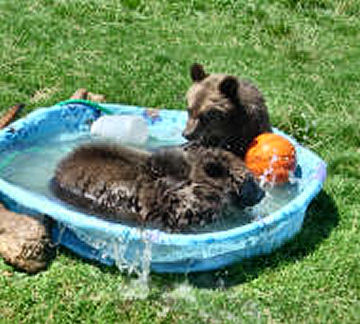 |
|
Two grizzly cubs play in a pool at the WSU Bear Center.
|
| Washington State University |
In their facility in Pullman, the researchers raised the animals. They used dog-training techniques to teach the cubs how to sit, lie down, and tolerate medical tests. The animals were quick learners.
“They’re incredibly smart,” Nelson says. “Often, we could show them what we wanted them to do just once, and they would get it from then on. It was really amazing.”
Sleepy time
To study hibernation, the researchers begin by reducing the amount of food the animals get. They do this when the weather starts turning cold in October, because in the wild, a declining supply of food is one factor that triggers hibernation. Soon after, the bears enter artificial dens made of concrete and filled with hay for warmth and comfort. There, they settle down for the winter, usually with one other bear that they choose themselves.
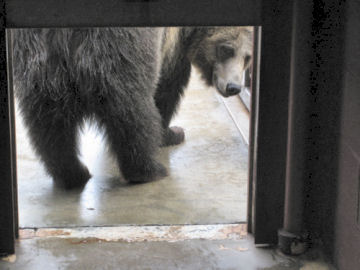 |
|
At the WSU Bear Center, grizzlies can roam between indoor and outdoor enclosures.
|
| Emily Sohn |
Four to six weeks later, the scientists enter the den to record heart measurements and other data from the bears. They do the same thing every month until the weather turns warmer.
So far, the research has revealed some surprises. The scientists have found, for example, that a grizzly’s heart rate not only drops during hibernation but also varies a lot. It can jump from 4 bpm one minute to 25 bpm the next, and then quickly drop back. Nelson’s studies also show that two of the four chambers in a grizzly’s heart stop beating during hibernation. The phenomenon has never been seen in any other type of hibernating animal, and scientists don’t know what it means.
In a human heart, dramatic changes in heart rate are signs that something is seriously wrong. Figuring out how and why the hearts of hibernating bears can do what they do and still stay healthy might give doctors clues about how to treat life-threatening heart problems in people.
For example, researchers could try to develop medicines that would allow a diseased human heart to temporarily rest, just as a hibernating bear’s heart does. If a sick person’s heart didn’t have to work so hard, Nelson says, he or she might be able to manage the disease better.
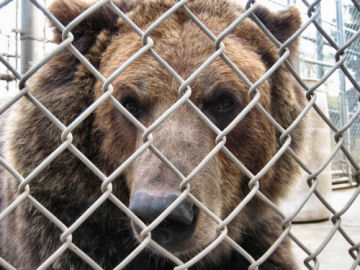 |
|
Grizzly bears may have a lot to teach scientists about the human heart.
|
| Emily Sohn |
And it’s not just the hearts of hibernating grizzlies that deserve attention from the medical community, Nelson says. For reasons scientists cannot yet explain, bears can hibernate for months without losing strength in their bones and muscles. When people must stay in bed for a long time for medical reasons, on the other hand, they lose both bone and muscle mass. That’s something doctors would like to prevent.
Getting the bear facts
Researching bears in a fenced-in facility can be interesting, but how much can studies of captive bears tell us about wild bears? A lot, say WSU researchers.
Graduate student Jennifer Fortin is studying what grizzly bears eat in Yellowstone National Park. Historically, Fortin says, Yellowstone’s grizzlies ate lots of cutthroat trout, a type of river fish. But cutthroat trout populations have crashed in recent years because of overfishing and habitat destruction. Scientists don’t know what the grizzlies are currently eating.
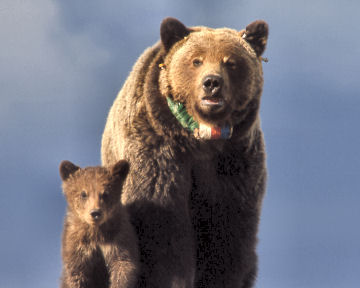 |
|
Scientists study grizzlies in places such as Yellowstone National Park by placing tracking collars on them, like the one this mama bear is wearing.
|
| NPS Photo by John Good |
To find out, Fortin and colleagues started with a study at the Bear Center. They fed known amounts of fish to the bears. Then, they analyzed the chemical composition of the bears’ hair. From the data they collected, the researchers created a formula to link fish consumption with mercury levels in the bears’ fur. (Fish have a metal called mercury in their bodies that they get from the environment. When bears eat the fish, they ingest the mercury, which later shows up in their hair.)
Next, the researchers moved out into the field. They outfitted wild bears with tracking collars that allowed them to trace the animals’ steps. As the scientists followed the bears’ trails, they collected the grizzlies’ droppings and hair. Using the formula they developed in the lab, the scientists are figuring out whether the wild bears are replacing cutthroat trout with other types of fish or are eating other kinds of food instead.
Results aren’t yet available, but Fortin hopes to use what she finds out to help Yellowstone’s grizzlies. Once they know what the bears eat, the park’s wildlife managers can better protect the animals’ food supply. In the same way, Nelson’s work with hibernation in the lab might help field biologists protect bears from noise and other disturbances that might stress the animals in the winter.
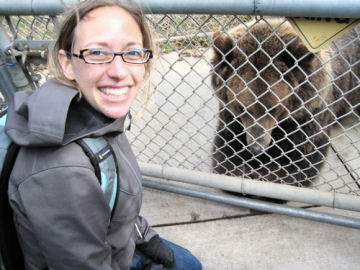 |
|
Science News for Kids reporter Emily Sohn gets up close and personal with a grizzly bear at the WSU Bear Center.
|
|
Courtesy of Emily Sohn
|
More than ever, some researchers say, grizzlies need this kind of protection. In the United States outside of Alaska, grizzly bear numbers have dropped to less than 1,000. A few centuries ago, the population topped 100,000.
Grizzly bears get a lot of attention when they steal food or hurt people, Fortin says. “But they don’t get enough publicity for the fact that they’re a unique species,” she says.
“They deserve our respect,” she adds. “And we have a responsibility to do our part in making sure that they can live as naturally as possible without our interference.”
Going Deeper:







